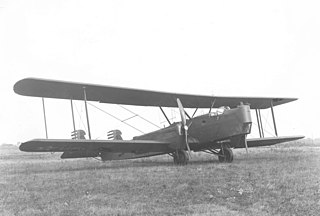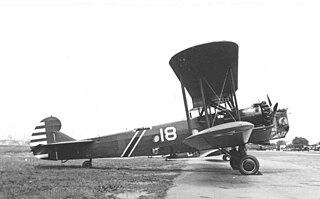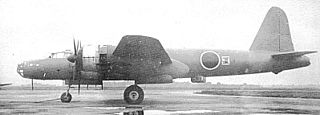
The Martin B-26 Marauder is an American twin-engined medium bomber that saw extensive service during World War II. The B-26 was built at two locations: Baltimore, Maryland, and Omaha, Nebraska, by the Glenn L. Martin Company.

The Martin XB-51 was an American trijet ground-attack aircraft. It was designed in 1945 and made its maiden flight in 1949. It was originally designed as a bomber for the United States Army Air Forces under specification V-8237-1 and was designated XA-45. The "A" ground-attack classification was eliminated the next year, and the XB-51 designation was assigned instead. The requirement was for low-level bombing and close support. The XB-51 lost out in evaluation to the English Electric Canberra which - built by Martin - entered service as the Martin B-57 Canberra.

The Bristol Type 163 Buckingham was a British Second World War medium bomber for the Royal Air Force (RAF). Overtaken by events, it was built in small numbers and was used primarily for transport and liaison duties.

The Huff-Daland XB-1 was a prototype bomber aircraft built for the United States Army Air Corps.

The Keystone B-6 was a biplane bomber developed by the Keystone Aircraft company for the United States Army Air Corps.

The Douglas Y1B-7 was a 1930s American bomber aircraft. It was the first US monoplane given the B- 'bomber' designation. The monoplane was more practical and less expensive than the biplane, and the United States Army Air Corps chose to experiment with monoplanes for this reason. At the time the XB-7 was ordered, it was being tested by Douglas Aircraft as an observational plane.
The Martin XB-16, company designation Model 145, was a projected heavy bomber designed in the United States during the 1930s.

The North American XB-21 and sometimes referred to by the name "Dragon", was a prototype bomber aircraft developed by North American Aviation in the late 1930s, for evaluation by the United States Army Air Corps. Evaluated against the Douglas B-18 Bolo, it was found to be considerably more expensive than the rival aircraft, and despite the ordering of a small number of evaluation aircraft, only the prototype was ever built.

The Douglas B-23 Dragon is an American twin-engined bomber developed by the Douglas Aircraft Company as a successor to the B-18 Bolo.

The Martin XB-27 was an aircraft proposed by the Glenn L. Martin Company to fill a strong need in the United States Army Air Corps for a high-altitude medium bomber. Its design was based approximately on that of Martin's own B-26 Marauder. The XB-27 remained on paper, and no prototypes were built.

The Lockheed XB-30 was the design submitted by Lockheed after the request by the United States Army Air Forces for a very heavy bomber, the same request that led to the Boeing B-29 Superfortress, the Douglas XB-31 and Consolidated B-32 Dominator.
The Douglas XB-31 was the design submitted by Douglas after the request by the United States Army Air Forces for a very heavy bomber aircraft, the same request that led to the Boeing B-29 Superfortress, Lockheed XB-30, and Consolidated B-32 Dominator.

The Mitsubishi Ki-67Hiryū was a twin-engine bomber produced by Mitsubishi Aircraft Company and used by the Imperial Japanese Army Air Service and Imperial Japanese Navy Air Service in World War II. While its original official designation was "Army Type 4 Heavy Bomber", in all of its key parameters, the Ki-67 was similar to the contemporaneous medium bombers of other countries. Japanese Navy variants included the P2M and Q2M.

The Nakajima G8N Renzan was a four-engined long-range bomber designed for use by the Imperial Japanese Navy. The Navy designation was "Type 18 land-based attack aircraft" (十八試陸上攻撃機); the Allied code name was "Rita".

The Martin XB-33 Super Marauder was a proposed World War II American bomber aircraft. It was designed by the Glenn L. Martin Company as the Martin Model 190 and was a high-altitude derivative of the company's B-26 Marauder. Two different designs were developed, first as a twin-engined aircraft and then as a four-engined aircraft. The four-engined version was ordered by the United States Army Air Forces, but the program was cancelled before any aircraft were built.
The Martin XB-68 was a supersonic medium tactical bomber with a crew of two that was proposed in 1954 to the United States Air Force. The project, however, was canceled before any aircraft were built.

The Convair XB-46 was a single example of an experimental medium jet bomber which was developed in the mid-1940s but which never saw production or active duty. It competed with similar designs, the North American XB-45 and Martin XB-48, all of which saw little use after the successful development of the Boeing XB-47.

The Martin XB-48 was an American medium jet bomber developed in the mid-1940s. It competed with the Boeing B-47 Stratojet, which proved to be a superior design, and was largely considered as a backup plan in case the B-47 ran into development problems. It never saw production or active duty, and only two prototypes, serial numbers 45-59585 and 45-59586, were built.

The Tachikawa Ki-74 was a Japanese experimental long-range reconnaissance bomber of World War II. A twin-engine, mid-wing monoplane, it was developed for the Imperial Japanese Army Air Service but never deployed in combat. The Ki-74 was designed for high altitude operation with a pressurized cabin for its crew.

The North American NA-40 was an American prototype bomber aircraft developed by North American Aviation in the late 1930s for evaluation by the United States Army Air Corps. Although unsuccessful, it led directly to the North American B-25 Mitchell medium bomber.




















